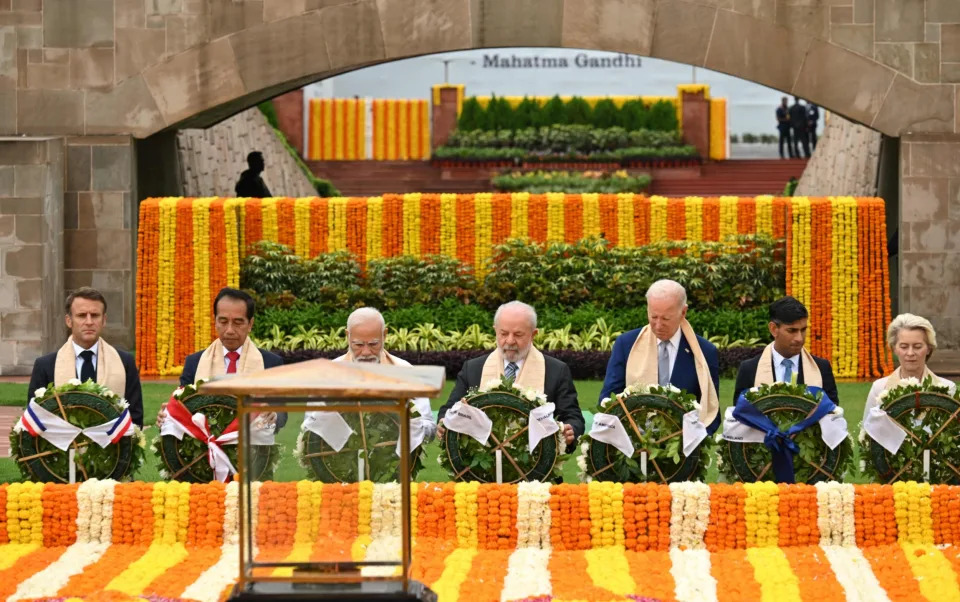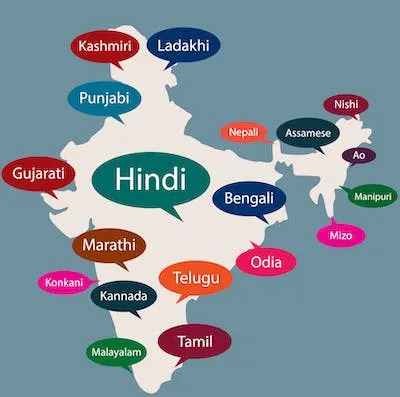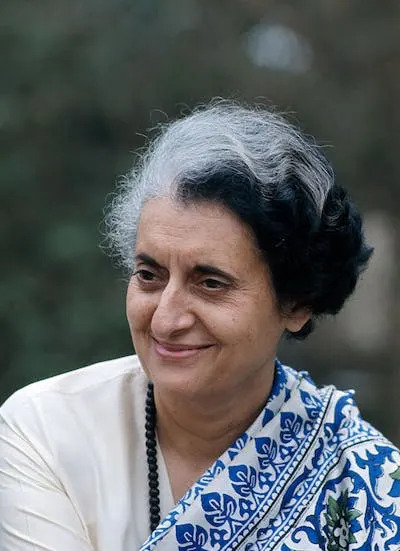India's Alleged Assassination of a Dissident in Canada Highlights Repression Across Borders
J.D. Tuccille
Wed, September 27, 2023
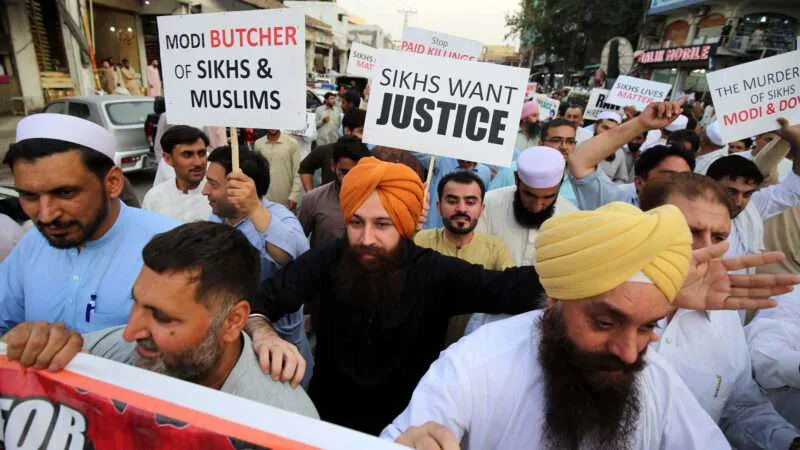
SA-ZM-220923 / Pakistan Press International Photo/Newscom
Canada and India are at odds over the Canadian government's claims that Indian agents assassinated Hardeep Singh Nijjar, a Sikh separatist leader, in British Columbia. The crime has damaged relations between the two countries, and it may be part of a growing and very troubling trend. If the hit really was state sponsored, it's one of a wave of such acts taken by governments against critics and dissidents who seek refuge on foreign soil.
"Prime Minister Justin Trudeau is accusing the government of India of involvement in the fatal shooting of a Canadian Sikh leader — a claim that will have seismic effects on an already shaky bilateral relationship," the CBC reported September 18. "Canadian citizen Hardeep Singh Nijjar was brazenly shot dead outside a Sikh temple in Surrey, B.C. on June 18."
Hardeep Singh Nijjar, who moved to Canada from India in 1997, was long of interest to the Indian government. A supporter of a separate state for Sikhs, Nijjar was accused of terrorism by Indian officials who offered a cash bounty for information leading to his arrest. They may not have stopped there; Canadian Security Intelligence Service officers apparently warned Nijjar that his life was in danger and the U.S. Ambassador to Canada says the Five Eyes intelligence alliance of the United States, the United Kingdom, Canada, Australia, and New Zealand supported Canadian Prime Minister Justin Trudeau's claim that Nijjar was targeted by Indian agents.
If he was targeted in his country of refuge by a government he'd offended, Hardeep Singh Nijjar is far from an isolated case.
Thugs Without Borders
"All over the world, individuals brave enough to speak out against repression are being targeted by autocrats who reach across borders to silence their voices," Freedom House warned this year. "Tactics of transnational repression—including assassinations, unlawful deportations, detentions, renditions, physical and digital threats, and coercion by proxy—are used by governments to stamp out dissent among diasporas and exiles living beyond their borders."
The Washington, D.C.-based organization claims to have "information on 854 direct, physical incidents of transnational repression committed by 38 governments in 91 countries around the world since 2014."
This isn't an entirely new phenomenon. Critics of Russia's government, in its old communist version and its current generically authoritarian flavor, have long had a habit of running afoul of poison, radioactive substances, open windows, and other lethal mishaps—often outside Moscow's jurisdiction.
"Russia was responsible for the killing of Alexander Litvinenko, the European Court of Human Rights (ECHR) has found," the BBC reported in 2021. "Litvinenko, a former Russian spy who became a British citizen, was fatally poisoned with radioactive polonium-210 in London in 2006."
But the practice of reaching beyond borders to target dissidents has become more common in recent years, with the Chinese government a major offender.
"The Chinese Communist regime, often with the aid of other governments, is systematically hunting down its political and religious exiles, no matter where in the world they seek refuge," Nate Schenkkan and Sarah Cook reported in 2021 for The Diplomat.
"Fox Hunt is a sweeping bid by General Secretary Xi [Jinping] to target Chinese nationals whom he sees as threats and who live outside China, across the world," FBI Director Christopher Wray charged in a 2020 speech. "We're talking about political rivals, dissidents, and critics seeking to expose China's extensive human rights violations. Hundreds of the Fox Hunt victims that they target live right here in the United States, and many are American citizens or green card holders."
In April of this year, authorities arrested two men accused of helping establish a secret Chinese "police station" in New York's Chinatown. "The PRC, through its repressive security apparatus, established a secret physical presence in New York City to monitor and intimidate dissidents and those critical of its government," according to U.S. Assistant Attorney General Matthew Olsen.
Likewise, the Saudi government is implicated in the infamous 2018 murder of journalist Jamal Khashoggi in Turkey. "American officials listened to a recording obtained by Turkish intelligence that not only captured Mr. Khashoggi's struggle against Saudi agents and his killing, but also the sounds of the saw being used on his body," reported The New York Times.
Turkey's government, it should be noted, cooperates with Beijing to silence Muslim Uyghur refugees who fled to Turkey, and it has sought assistance in muzzling its own dissidents. "Uzbekistani security services helped abduct a man from his apartment in Tashkent and return him to Turkey," notes Freedom House.
Transnational Repression Isn't Just for Dictators
This is where matters get more disturbing. While increasingly illiberal, Turkey still has elections and (eroding) domestic debate. The same can be said of India, which is drifting in an autocratic direction but is not (yet) explicitly authoritarian. If India's elected government is responsible for Nijjar's assassination, that means transnational repression isn't just a vice of central-casting dictators.
Even countries usually considered free are guilty. Journalist Julian Assange was seized by the U.K. at the behest of the United States on what Amnesty International describes as "politically motivated charges." Then-Bolivian President Evo Morales's plane was forced to land in Austria in 2013 by European governments cooperating with the U.S. on suspicion that whistleblower Edward Snowden was aboard.
Freedom House rightfully complains, "because so many democratic countries have adopted policies that harden their borders and discourage asylum seekers, people who advocate for human rights or defend democratic principles in harsh environments are often forced to remain in parts of the world where autocrats make the rules." On the assumption that some countries are true safe harbors for peaceful dissenters, the organization wants free countries to be more welcoming and protective to refugees.
But democratic countries are only refuges if they're not actively assisting other regimes in acts of transnational repression or engaging in the practice themselves. As it is, while peaceful dissidents and critics of all sorts are certainly better off in more-open societies than under explicitly authoritarian regimes, their safety is relative. How much protection they enjoy is subject not only to the competency of local authorities, but also to how well-disposed they are to specific asylum-seekers.
Canada's government may be doing its best to bring Hardeep Singh Nijjar's assassins to account. But government officials are always jealous of their power, and no place is truly safe for those who cross thin-skinned officials.
The post India's Alleged Assassination of a Dissident in Canada Highlights Repression Across Borders appeared first on Reason.com.
‘Whether it costs our lives or not’: killing of Canadian Sikh leader reignites historic fight
Leyland Cecco in Toronto and Sarah Berman in Vancouver
Wed, September 27, 2023
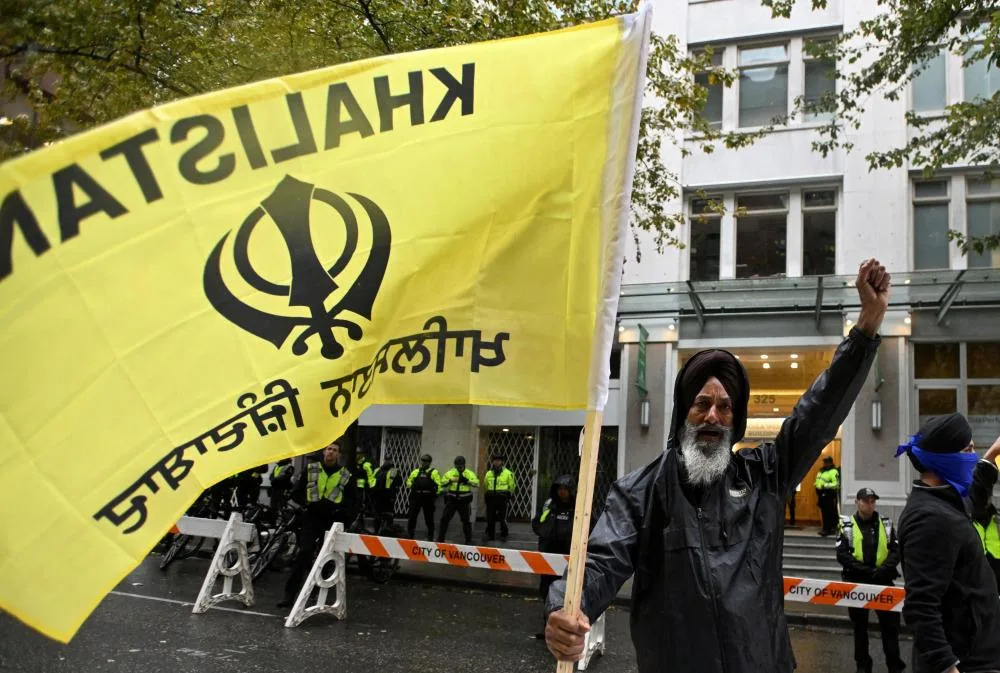
Photograph: Jennifer Gauthier/Reuters
Yellow and blue smoke filled the air as protesters in Vancouver tried setting fire to a damp Indian flag. As the flame eventually took hold, people in the crowd waved Sikh separatist flags and chanted calls for the expulsion of India’s top diplomat in Canada.
Tuesday’s protest outside a heavily guarded Indian consulate came a week after Justin Trudeau, the prime minister, told parliament his government had seen “credible allegations” that India was responsible for the fatal shooting of Hardeep Singh Nijjar, a prominent Canadian Sikh leader.
Related: ‘Very messy’: India-Canada row over Sikh killing causes diplomatic shock waves
Amid the pounding of drums and shouts from protesters, activist Harkeerat Kaur told the crowd that Nijjar’s final words to temple worshippers had been a plea to participate in an upcoming vote calling for an independent Sikh homeland, Khalistan: “[He] stated … we should vow to participate in the peaceful Khalistan referendum. We believe in the ballot.”
Since his death in June, Nijjar has been praised by his community as a martyr – and labelled a terrorist by India. The feuding over his legacy, and mounting concern over what Canada’s government claims was an extrajudicial murder on its soil, has refocused attention on Canada’s Sikh diaspora, their longstanding grievances with India – and the Sikh separatist cause.
Canada is home to the largest Sikh community outside India. Despite a long and layered history in the country, many Canadian Sikhs identify with a sense of historical mistreatment at the hands of both British colonial and post-independence governments in India, said Satwinder Bains, the director of South Asian studies at the University of the Fraser Valley. “They’ve felt those frustrations have never been resolved through the justice system, nor through a parliamentary system. They feel like they’ve tried everything,” she said.
Over generations, some have cultivated hope that Sikhs might one day claim a portion of the Punjab region as their own.
That dream has a long – and violent – history. Beginning around partition in the 1940s, the movement transformed into an armed insurgency in the 1980s, under the leadership of Jarnail Singh Bhindranwale.
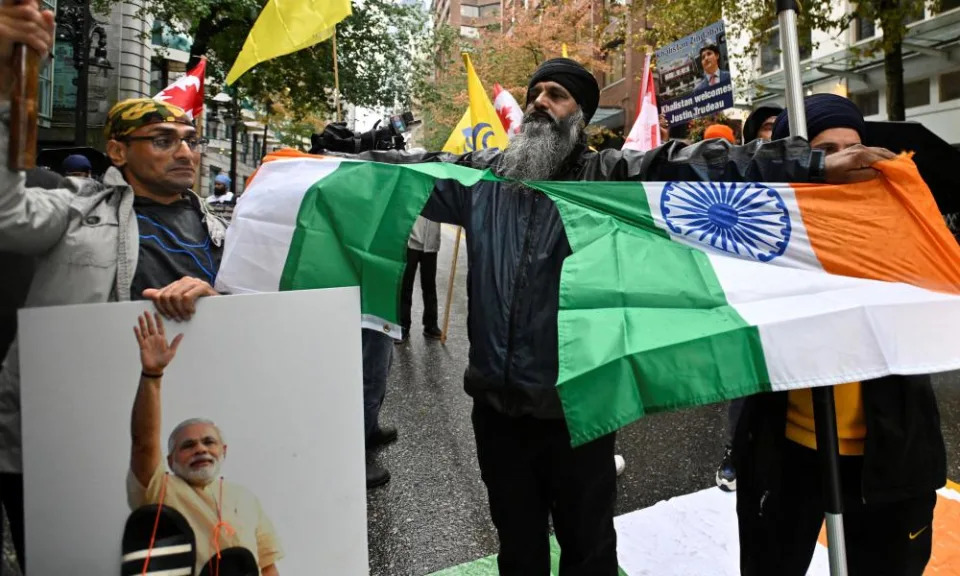
The Indian flag is torn during a protest outside India’s consulate in Vancouver, British Columbia, Canada on 25 September 2023. Photograph: Jennifer Gauthier/Reuters
In 1984, the Sikh leader, who stood accused of orchestrating a series of attacks on Hindus in Punjab, sought refuge in Amritsar’s Golden Temple alongside other militants.
The Indian army ordered Operation Blue Star, an attack that led to the killing of 400 Sikhs in the temple, many of whom were pilgrims. In retaliation, the bodyguards for Indira Gandhi, the prime minister, shot her dead, triggering anti-Sikh pogroms that killed more than 3,000 people, with little consequence for the attackers.
“It was a horrific time. And in those moments, the idea of Khalistan, of a safe haven for Sikhs, really meant something,” said Neilesh Bose, an associate professor of history at the University of Victoria.
In 1985, Khalistani militants in Canada targeted two Air India flights, widely seen as revenge for Operation Blue Star. A bomb on Air India flight 182 exploded off the coast of Ireland, killing all 329 people onboard, including 268 Canadian citizens, 27 British citizens and 24 Indian citizens in the worst act of aviation terrorism before the September 11 attacks. The second bomb exploded in the Tokyo airport, killing two baggage handlers. The attacks led to discrimination against Sikh men, identifiable by their turbans, even though many had little interest in the Khalistan cause.
“Punjabi Sikhs in Canada were often seen as enemies of the state, targeted by police and seen as responsible for this attack,” said Bose, adding that both the bombings and public backlash changed how the Sikh diaspora saw itself in the broader Canadian public. “These events – 1984, the Air India bombing – they’re inescapable for so many in the Sikh community. Everybody lives in this context of these moments, and these inescapable legacies.”
The Khalistan movement is banned in India, but in Canada generations of Sikh activists have freely advocated for an independent homeland. While political leaders have emphasised the right to free speech and expression in Canada, they have also long courted the Sikh community as a powerful voting bloc.
That has prompted frustration in India, which has accused Canada of turning a blind eye to extremist Khalistani activity and refusing to act on information about potential threats. Before the Air India bombing, the Royal Canadian Mounted Police (RCMP) failed to act on intel from India about plots against airliners, and successive Canadian governments have refused extradition requests of Sikh activists from India.
Indian authorities allege Nijjar was among the Khalistani activists involved in terrorist activity on Canadian soil. They have accused him of organising an arms training camp for Sikh extremists in British Columbia in 2016, being involved in a plot to assassinate a Hindu priest and police officers in Punjab and heading a banned militant organisation, the Khalistani Tiger Force. The allegations, which he denied, were not investigated by the Canadian authorities and remain unproven.
It remains unclear how popular the Khalistan cause is within Canada’s Sikh population. For some, the movement is forever tainted by violence and the painful legacy of the Air India bombing. For others, it represents a powerful way to counter India’s Hindu nationalist government and the growing persecution of religious minorities.
Already this year, thousands in Ontario and British Columbia have cast ballots in a Khalistan referendum, a global diaspora effort as Sikh activists attempt to unify the disparate groups and co-ordinate pressure on the Indian government.
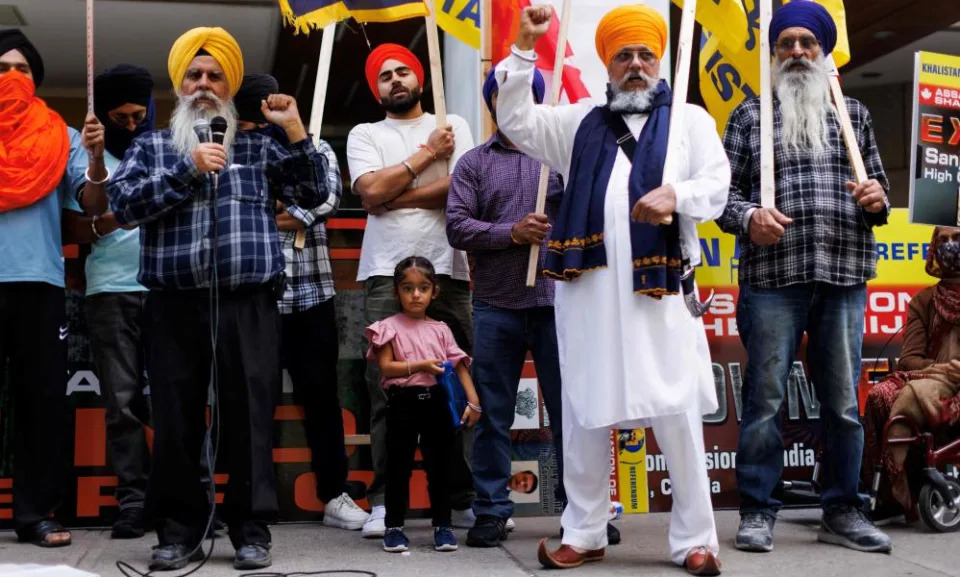
Demonstrators rally in support of Khalistan outside the Indian consulate in Toronto on 25 September 2023. Photograph: Cole Burston/AFP/Getty Images
The ballots come as a younger generation has grown more emboldened and provocative. In June, a Sikh group in the city of Brampton prompted outrage with a parade float depicting the assassination of Indira Gandhi, which included a blood-splattered effigy of the murdered leader.
On posters for the referendum championed by leadership at the Guru Nanak gurdwara where Nijjar was shot dead, his image appears alongside a photo of the architect of the Air India bombing.
Such incidents have infuriated India. But the brazen murder of Nijjar – which reportedly involved at least six men who fired around 50 bullets – is only likely to sow further mistrust and resentment among a new generation of Sikhs.
Related: ‘His spirit is still among us’: Sikhs defiant in Canada city where activist was murdered
“These are Canadian-born children. They may never have set foot in Punjab,” said Bains. “But through their parents’ or grandparents’ eyes, they have seen the pain, the anger and hurt. And those feelings have been exacerbated over the years because there has been no justice and no closure.”
Indervir Singh, 36, who attended Monday’s rally, said that Nijjar’s death in June and Trudeau’s subsequent allegations are only a reminder of the escalating human rights abuses in India.
“I’m born here. Ever since I was a kid you heard about the atrocity in 1984 when the government killed thousands of innocent people,” Singh said. “We’ve always been rallying against that, fighting against that, and trying to get justice for that.”
Singh said he joined protests in support of Sikh farmers in 2021, but had largely been ambivalent about the pro-separatist movement. “Personally I didn’t really think about it, nor was I supporting it,” he said. “But now that this happened, I think from a sovereignty perspective we’re demanding that.”
While he doubts independence could ever be achieved in India, he said: “As Sikhs we’re known to fight against injustice – whether it costs our lives or not.”
Stephanie Kirchgaessner in Washington
Mon, September 25, 2023
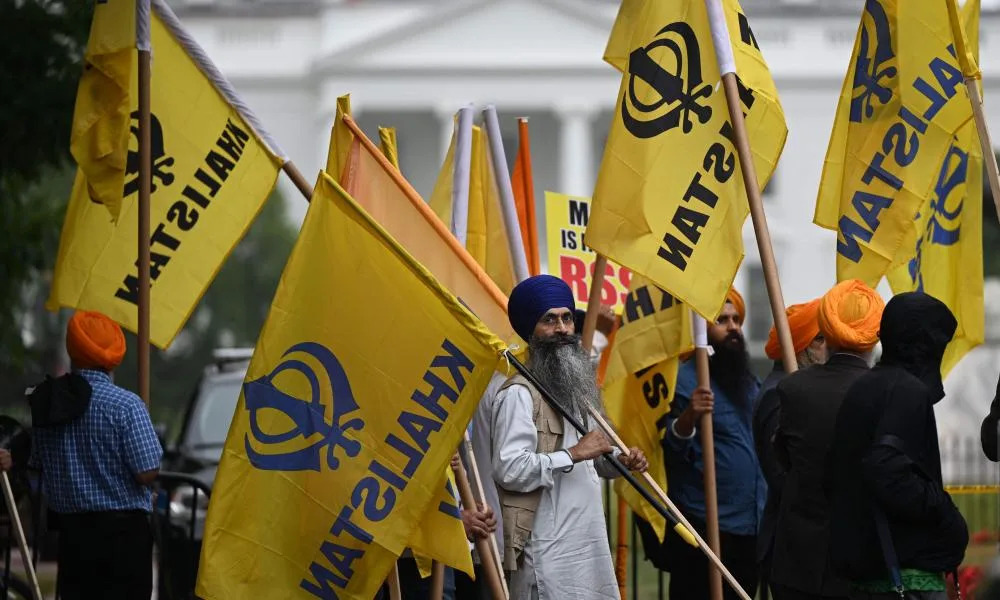
Photograph: Pedro Ugarte/AFP/Getty Images
The FBI warned at least three Americans active in the Sikh community that their lives were in danger in the immediate aftermath of the murder of a Sikh activist in Canada in June.
Canadian prime minister Justin Trudeau has blamed the apparent assassination on the Indian government, as assessment that has reportedly been backed by Canadian and US intelligence sources and has created a rupture in Ottawa’s relationship with Indian prime minister Narendra Modi’s government.
The shocking accusation that India carried out an extrajudicial murder on Canadian soil – an allegation that has been denied by India – has prompted a re-examination of threats against Sikh separatists around the world, as well as Sikh activists’ claims of suspicious deaths in the UK and Pakistan in the weeks before the murder.
Related: India-Canada row: Blinken calls on Delhi to cooperate in push for ‘accountability’ over killing
Pritpal Singh, a 69-year-old US citizen who serves as a coordinator for the American Sikh Caucus Committee, confirmed to the Guardian that he and two other associates were called by the FBI just days after the murder of Hardeep Singh Nijjar, the Canadian citizen who was ambushed on 18 June just outside his place of worship in Surrey, British Columbia.
The FBI, which must warn citizens if they learn that their lives are in danger under a legal protection known as a “duty to warn”, initially told Singh that it believed his life was under threat because of unspecified intelligence. A few days later, the FBI offered Singh more specific safety instructions. The Intercept first reported the case.
“Such intimidation of Americans is a form of transnational repression by the Indian government,” Singh said in a statement to the Guardian. “Transnational repression not only threatens individuals but also undermines our democratic institutions, curtails individual rights and freedoms, and challenges the national security and sovereignty of the United States.”
The FBI also warned another American named Amarjit Singh, a 70-year-old New York-based journalist and commentator who said he was first alerted of a possible threat against his life on 22 June. Singh told the Guardian that he was contacted by the FBI as he was returning from a protest against Modi in Washington, during a state visit in which US president Joe Biden hailed the US-India relationship as “stronger, closer, and more dynamic than at any time in history”.
In an interview in which he publicly revealed details of the threat for the first time, Amarjit Singh said the initial call from the FBI was followed up a few weeks later by a longer in-person meeting, at which point he said it was obvious that authorities were warning against a possible threat on his life by India.
“It was a warning. They said no travel, just keep yourself safe,” he said. Amarjit Singh said he only decided to go public with his account after Trudeau revealed Canada’s conclusion about Nijjar’s murder.
New details emerged on Monday about the killing of Nijjar. Citing a security video that captured the murder, the Washington Post reported that at least six men and two vehicles were involved in Nijjar’s killing, in what the newspaper said was a larger and more organised assassination plot than has previously been reported. The assailants fired about 50 bullets, and 34 hit Nijjar.
Nijjar, who was 45, was a leader in the Khalistan movement in Canada, which has called for the creation of an independent Sikh state in the Punjab region of India. The movement has been outlawed in India in the wake of allegations of that supporters of the separatist movement are terrorists.
Media attention has focused largely on Trudeau’s accusation that India was behind the murder. But Canadian authorities are also facing questions about why more was not done to protect Nijjar.
Moninder Singh, a spokesperson for the British Columbia Gurdwaras Council, was one of five people – including Nijjar – who was warned by Canadian authorities in 2022 that their lives were at imminent risk.
“We were never told what the risk was or where it was coming from. But we assumed it was India, because of our activism and outspokenness,” he said. “We expect them to attack us in the media, or character assassination, so this was shocking.”
While he was told to leave his home to protect his young family, Moninder Singh said none of them were offered special protection. Weeks later, Singh was told that the threat against him had dissipated, but the threat against Nijjar – a close friend and mentor – remained.
“There was no other information shared,” Singh said. “While there is an appreciation of Trudeau’s statement, it’s a bit late.”
‘Whether it costs our lives or not’: killing of Canadian Sikh leader reignites historic fight
Leyland Cecco in Toronto and Sarah Berman in Vancouver
Wed, September 27, 2023

Photograph: Jennifer Gauthier/Reuters
Yellow and blue smoke filled the air as protesters in Vancouver tried setting fire to a damp Indian flag. As the flame eventually took hold, people in the crowd waved Sikh separatist flags and chanted calls for the expulsion of India’s top diplomat in Canada.
Tuesday’s protest outside a heavily guarded Indian consulate came a week after Justin Trudeau, the prime minister, told parliament his government had seen “credible allegations” that India was responsible for the fatal shooting of Hardeep Singh Nijjar, a prominent Canadian Sikh leader.
Related: ‘Very messy’: India-Canada row over Sikh killing causes diplomatic shock waves
Amid the pounding of drums and shouts from protesters, activist Harkeerat Kaur told the crowd that Nijjar’s final words to temple worshippers had been a plea to participate in an upcoming vote calling for an independent Sikh homeland, Khalistan: “[He] stated … we should vow to participate in the peaceful Khalistan referendum. We believe in the ballot.”
Since his death in June, Nijjar has been praised by his community as a martyr – and labelled a terrorist by India. The feuding over his legacy, and mounting concern over what Canada’s government claims was an extrajudicial murder on its soil, has refocused attention on Canada’s Sikh diaspora, their longstanding grievances with India – and the Sikh separatist cause.
Canada is home to the largest Sikh community outside India. Despite a long and layered history in the country, many Canadian Sikhs identify with a sense of historical mistreatment at the hands of both British colonial and post-independence governments in India, said Satwinder Bains, the director of South Asian studies at the University of the Fraser Valley. “They’ve felt those frustrations have never been resolved through the justice system, nor through a parliamentary system. They feel like they’ve tried everything,” she said.
Over generations, some have cultivated hope that Sikhs might one day claim a portion of the Punjab region as their own.
That dream has a long – and violent – history. Beginning around partition in the 1940s, the movement transformed into an armed insurgency in the 1980s, under the leadership of Jarnail Singh Bhindranwale.

The Indian flag is torn during a protest outside India’s consulate in Vancouver, British Columbia, Canada on 25 September 2023. Photograph: Jennifer Gauthier/Reuters
In 1984, the Sikh leader, who stood accused of orchestrating a series of attacks on Hindus in Punjab, sought refuge in Amritsar’s Golden Temple alongside other militants.
The Indian army ordered Operation Blue Star, an attack that led to the killing of 400 Sikhs in the temple, many of whom were pilgrims. In retaliation, the bodyguards for Indira Gandhi, the prime minister, shot her dead, triggering anti-Sikh pogroms that killed more than 3,000 people, with little consequence for the attackers.
“It was a horrific time. And in those moments, the idea of Khalistan, of a safe haven for Sikhs, really meant something,” said Neilesh Bose, an associate professor of history at the University of Victoria.
In 1985, Khalistani militants in Canada targeted two Air India flights, widely seen as revenge for Operation Blue Star. A bomb on Air India flight 182 exploded off the coast of Ireland, killing all 329 people onboard, including 268 Canadian citizens, 27 British citizens and 24 Indian citizens in the worst act of aviation terrorism before the September 11 attacks. The second bomb exploded in the Tokyo airport, killing two baggage handlers. The attacks led to discrimination against Sikh men, identifiable by their turbans, even though many had little interest in the Khalistan cause.
“Punjabi Sikhs in Canada were often seen as enemies of the state, targeted by police and seen as responsible for this attack,” said Bose, adding that both the bombings and public backlash changed how the Sikh diaspora saw itself in the broader Canadian public. “These events – 1984, the Air India bombing – they’re inescapable for so many in the Sikh community. Everybody lives in this context of these moments, and these inescapable legacies.”
The Khalistan movement is banned in India, but in Canada generations of Sikh activists have freely advocated for an independent homeland. While political leaders have emphasised the right to free speech and expression in Canada, they have also long courted the Sikh community as a powerful voting bloc.
That has prompted frustration in India, which has accused Canada of turning a blind eye to extremist Khalistani activity and refusing to act on information about potential threats. Before the Air India bombing, the Royal Canadian Mounted Police (RCMP) failed to act on intel from India about plots against airliners, and successive Canadian governments have refused extradition requests of Sikh activists from India.
Indian authorities allege Nijjar was among the Khalistani activists involved in terrorist activity on Canadian soil. They have accused him of organising an arms training camp for Sikh extremists in British Columbia in 2016, being involved in a plot to assassinate a Hindu priest and police officers in Punjab and heading a banned militant organisation, the Khalistani Tiger Force. The allegations, which he denied, were not investigated by the Canadian authorities and remain unproven.
It remains unclear how popular the Khalistan cause is within Canada’s Sikh population. For some, the movement is forever tainted by violence and the painful legacy of the Air India bombing. For others, it represents a powerful way to counter India’s Hindu nationalist government and the growing persecution of religious minorities.
Already this year, thousands in Ontario and British Columbia have cast ballots in a Khalistan referendum, a global diaspora effort as Sikh activists attempt to unify the disparate groups and co-ordinate pressure on the Indian government.

Demonstrators rally in support of Khalistan outside the Indian consulate in Toronto on 25 September 2023. Photograph: Cole Burston/AFP/Getty Images
The ballots come as a younger generation has grown more emboldened and provocative. In June, a Sikh group in the city of Brampton prompted outrage with a parade float depicting the assassination of Indira Gandhi, which included a blood-splattered effigy of the murdered leader.
On posters for the referendum championed by leadership at the Guru Nanak gurdwara where Nijjar was shot dead, his image appears alongside a photo of the architect of the Air India bombing.
Such incidents have infuriated India. But the brazen murder of Nijjar – which reportedly involved at least six men who fired around 50 bullets – is only likely to sow further mistrust and resentment among a new generation of Sikhs.
Related: ‘His spirit is still among us’: Sikhs defiant in Canada city where activist was murdered
“These are Canadian-born children. They may never have set foot in Punjab,” said Bains. “But through their parents’ or grandparents’ eyes, they have seen the pain, the anger and hurt. And those feelings have been exacerbated over the years because there has been no justice and no closure.”
Indervir Singh, 36, who attended Monday’s rally, said that Nijjar’s death in June and Trudeau’s subsequent allegations are only a reminder of the escalating human rights abuses in India.
“I’m born here. Ever since I was a kid you heard about the atrocity in 1984 when the government killed thousands of innocent people,” Singh said. “We’ve always been rallying against that, fighting against that, and trying to get justice for that.”
Singh said he joined protests in support of Sikh farmers in 2021, but had largely been ambivalent about the pro-separatist movement. “Personally I didn’t really think about it, nor was I supporting it,” he said. “But now that this happened, I think from a sovereignty perspective we’re demanding that.”
While he doubts independence could ever be achieved in India, he said: “As Sikhs we’re known to fight against injustice – whether it costs our lives or not.”
India says murdering separatists abroad is ‘not our policy’ amid Canada row
Alisha Rahaman Sarkar
Wed, September 27, 2023 at 4:19 AM MDT·3 min read
4
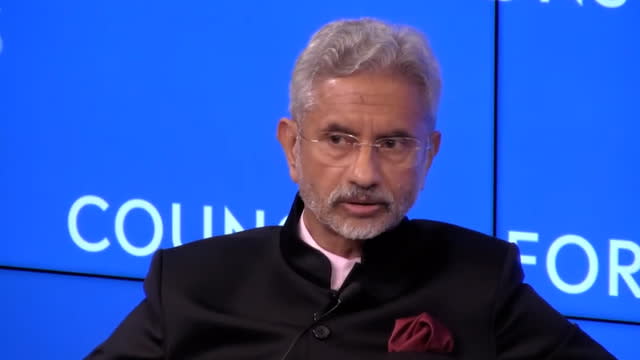
Scroll back up to restore default view.
India has told Canada that it was not the government’s “policy” to be involved in acts such as the assassination of Sikh separatist leader Hardeep Singh Nijjar on foreign soil.
Ties between India and Canada plummeted after prime minister Justin Trudeau accused New Delhi of involvement in the killing of the Canadian national.
Nijjar – a designated terrorist in India – was killed in Surrey on 18 June by two masked men, who fired an estimated 30 to 50 shots at him. He has been linked to the secessionist Khalistan movement, which calls for a separate homeland for the Sikh religious community to be carved out of India's Punjab state.
Mr Trudeau has repeatedly asked India for cooperation in the investigation, but India has rejected the allegations as "absurd" and "motivated".
When asked about the allegations at a Council on Foreign Relations event in New York, foreign minister Subrahmanyam Jaishankar detailed India's response.
"We told the Canadians that this is not the government of India's policy," Mr Jaishankar said.
"Second, we told the Canadians that ‘look, if you have something specific let us know we are open to looking at it’."
India responded to Ottawa's allegations by suspending visa services in all categories for Canadian nationals citing “security threats” to its consulates. Each country expelled one senior diplomat from the other in a tit-for-tat move.
“If somebody gives me something specific, it doesn’t have to be restricted to Canada. But if there’s any incident which is an issue and somebody gives me something specific, as a government, I would look at it,” the minister added.
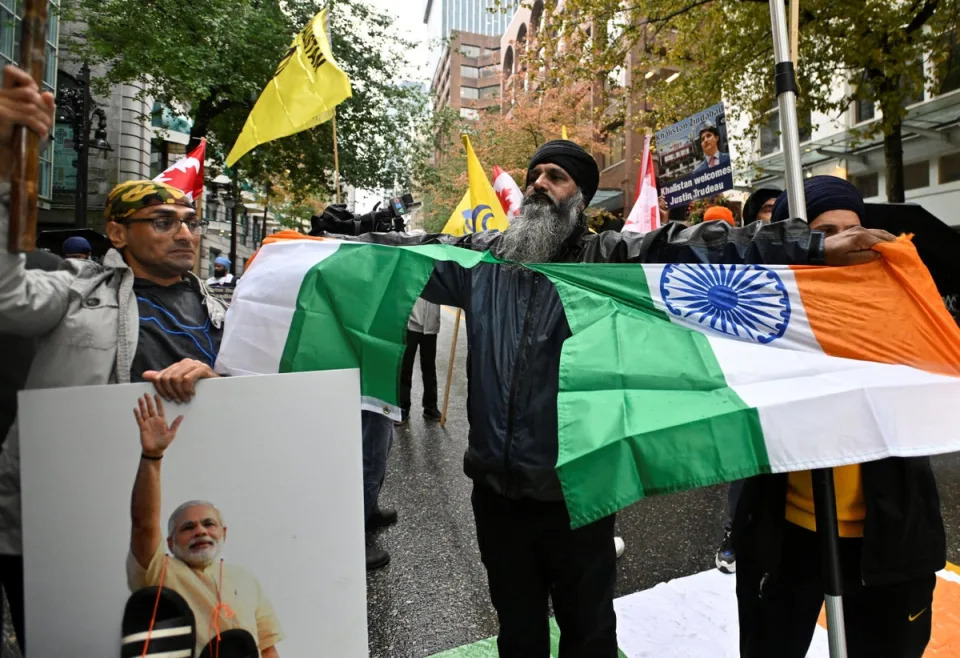
The Indian flag is torn during a protest in Vancouver, British Columbia, Canada (REUTERS)
Canada also urged its citizens to “remain vigilant and exercise caution” due to a rise in "some negative sentiment towards Canada on social media".
Mr Jaishankar said India had been "badgering the Canadians" about its claims that organised criminals are based in the Western nation. Canada is home to 770,000 Sikhs – the highest population from the religion outside the state of Punjab in India.
"In the last few years, Canada actually has seen a lot of organised crime, relating to the secessionist forces, organised crime, violence and extremism. They're all very, very deeply mixed up. So in fact, we have been talking about specifics and information," the foreign minister said.
He said India had made a large number of "extradition requests" and identified "terrorist leaders".
"Our concern is that it's really been very permissive, because of political reasons. So we have a situation where our diplomats are threatened, our consulates have been attacked... A lot of this is often justified, as saying that's how democracies work.”
In recent months Sikh protesters pulled down the Indian flag at the country’s High Commission in London and smashed the building’s window in a show of anger against the move to arrest another Sikh leader. Protesters also smashed windows at the Indian consulate in San Francisco and clashed with embassy workers.
Canadian Sikhs protest over activist's murder
Mon, September 25, 2023
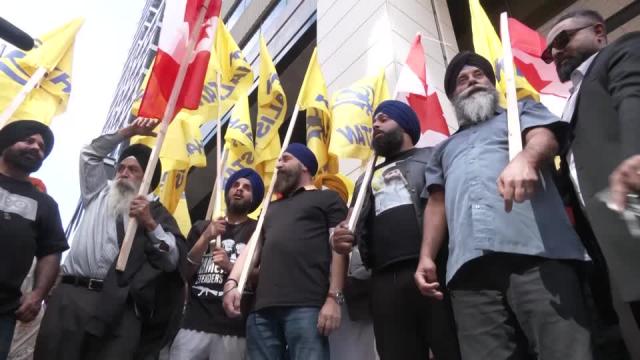
Canadian Sikhs protest over activist's murder
STORY: Trudeau a week ago stood in parliament to say that domestic intelligence agencies were actively pursuing credible allegations tying New Delhi's agents to the shooting of Canadian citizen Hardeep Singh Nijjar, 45, in June.
About 100 protesters in Toronto burned an Indian flag and struck a cardboard cut-out of Indian Prime Minister Narendra Modi with a shoe. About 200 protesters also gathered outside the Vancouver consulate.
Canada is home to about 770,000 Sikhs - the highest population of Sikhs outside their home state of Punjab - and in recent years there have been many demonstrations that have irked India.
India labeled Trudeau's allegations "absurd." It warned travelers last week that there were growing "anti-India activities" in Canada, urging "utmost caution" but did not provide evidence or details of specific incidents.
The West’s love-in with India could be coming to an abrupt end
Ben Wright
Mon, September 25, 2023
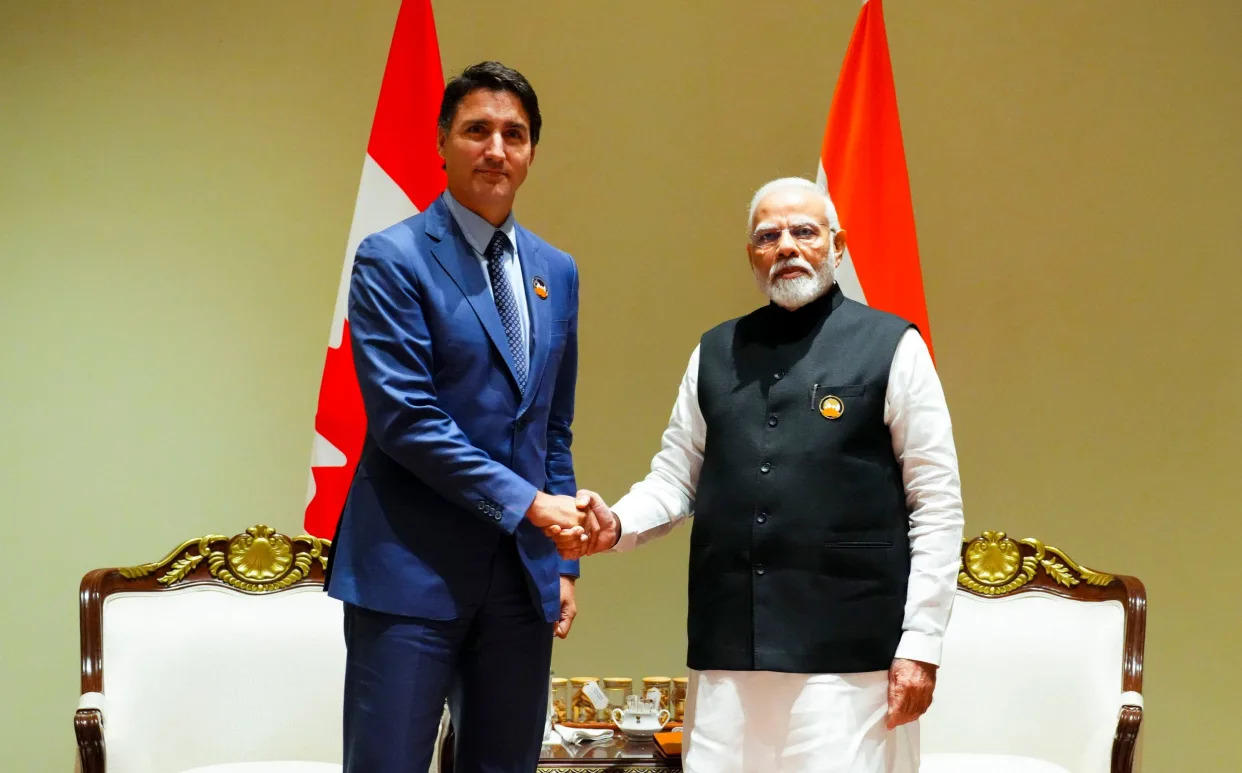
The fact that two erstwhile friendly nations are trading such caustic blows means that there has already been a huge failure of diplomacy - Sean Kilpatrick/The Canadian Press
Canada’s dispute with India has the potential to get very messy very quickly.
Last week, Canadian prime minister Justin Trudeau claimed his country’s intelligence services had uncovered “credible allegations” that India was behind the gunning down in June of Hardeep Singh Nijjar in the car park outside a Sikh temple in a suburb of Vancouver.
The Indian government has described Canada’s accusations as “absurd and motivated”, adding that Ottawa is seeking to “shift the focus from Khalistani terrorists and extremists, who have provided shelter in Canada and threaten India’s sovereignty and territorial integrity”.
It is an extraordinary spat and one that other countries are doing their level best not to get drawn into.
Jake Sullivan, President Biden’s national security adviser, has said the allegations are a “matter of concern”. Downing Street’s official response is that it doesn’t want to “get ahead” of any investigation.
It’s unlikely such studiously neutral statements will be sufficient. Over the weekend it emerged in a New York Times report that intelligence shared by the US with Canada had contributed to Trudeau’s public allegation that India had played a role in the Sikh activist’s murder.
At this point there are really only two possibilities: either Canada has committed an enormous diplomatic gaffe based on flawed US intelligence or India has something to hide.
With the stakes so high and the dispute so resolutely out in the open it is hard to see how the two countries might be able to engineer an elegant climbdown even if there was the appetite to do so.
It is equally hard to imagine how other countries will be able to resist being sucked into the quarrel. They will certainly try though. Many Western countries have expended a huge amount of time and energy in courting India in recent months.
Western politicians are hoping to secure access to India’s burgeoning market and fast-growing economy.
They also want to hasten the rise of what is now the world’s most populous country in the hope that it will become a second economic centre of gravity to rival China in the Indo-Pacific region.
Earlier this year President Biden invited Narendra Modi to address both Houses of US Congress. More recently, President Emmanuel Macron asked India’s prime minister to attend Bastille Day celebrations as guest of honour, despite Le Monde branding the gesture a “miscalculation”.
In pursuing their agenda, Western politicians have chosen to overlook the fact that New Delhi has refused to unequivocally condemn Russia’s invasion of Ukraine and has busily increased its imports of Urals oil at knock-down prices since the imposition of Western sanctions against Moscow.
Western governments have also faced criticism for turning a blind eye to accusations that Modi’s brand of Hindu nationalism has resulted in anti-Muslim chauvinism and an undermining of national institutions – accusations that New Delhi strongly denies.
Canada’s sensational claims will likely place additional focus on such realpolitik.
Certainly, neither Ottawa or New Delhi appear likely to back down any time soon. Canada is home to nearly 800,000 Sikhs, including Jagmeet Singh, the leader of the New Democratic Party, which is in coalition with Trudeau’s Liberal Party.
Modi, for his part, paints the pro-Khalistan movement, of which Nijjar was a vocal proponent, as an existential threat to India’s very existence.
Calls for the creation of an independent Sikh homeland gathered force in the 1970s and peaked in deadly clashes with Indian security forces in Punjab and the assassination of prime minister Indira Gandhi by her Sikh bodyguard in 1984.
The issue has been a stumbling block in Canada-India relations for years. Indeed, Indira Gandhi raised the issue with Pierre Trudeau, Justin’s father, when he was Canada’s prime minister in 1982.
In 1985 a Khalistani separatist group blew up an Air India flight from Montreal, killing 329 people in the worst terrorist attack in Canada’s history.
Western politicians have chosen to overlook the fact that New Delhi has refused to unequivocally condemn Russia’s invasion of Ukraine - KENNY HOLSTON/AFP
Today, the pro-Khalistan movement appears to have little traction within India but retains some hold among the Sikh diaspora around the world. These communities are mainly concentrated in Canada, the US, the UK and Australia – four of the Five Eyes intelligence-sharing alliance.
New Delhi remains convinced Ottawa is not doing enough to stop those that India accuses of being terrorists; Canada counters that pressure groups should be free to express their views as long as they do so peacefully.
Observers noticed that at the recent G20 meeting in New Delhi, most foreign leaders were picked up at the airport in either a Mercedes or an Audi but Trudeau was met by an old Toyota. If the insult was calculated to keep the Canadian prime minister quiet it didn’t work.
He raised concerns about Nijjar’s murder with Modi “personally and directly”. The official Indian readout from the meeting accused Canada of being a “nexus” of religious militancy, “organised crime, drug syndicates and human trafficking”. Trade talks between the two countries are – unsurprisingly – on ice.
Clearly, there is lots that remains unknown about this case. But the fact that two erstwhile friendly nations are trading such caustic blows means that there has already been a huge failure of diplomacy.
Even if only rhetorically, India’s approach to foreign policy in general and its campaign against active supporters of militant separatism based abroad has stepped up several notches.
If it turns out there’s any basis to Canada’s claims, Western powers will have to totally reassess their assumptions. Part of India’s appeal as a rival to China is that it is a democracy that respects the rule of law.
Those countries with large Sikh communities – the UK included – will have to tread extremely carefully, especially in the febrile atmosphere that will undoubtedly build ahead of India’s next general election in May.
Foreign affairs experts say there are growing suggestions that New Delhi believes London is not taking India’s concerns about the perceived issue of Khalistani radicals seriously.
This may be one of the reasons why trade talks between the two countries have stalled and why Rishi Sunak’s planned meeting with Modi on the eve of the G20 summit was abruptly cancelled.
There is still a great deal that the West doesn’t fully understand about India. It had better start learning quickly.
Air India flight 182: 1985 bombing back in news after Canada row
Sharanya Hrishikesh - BBC News, Delhi
Wed, September 27, 2023
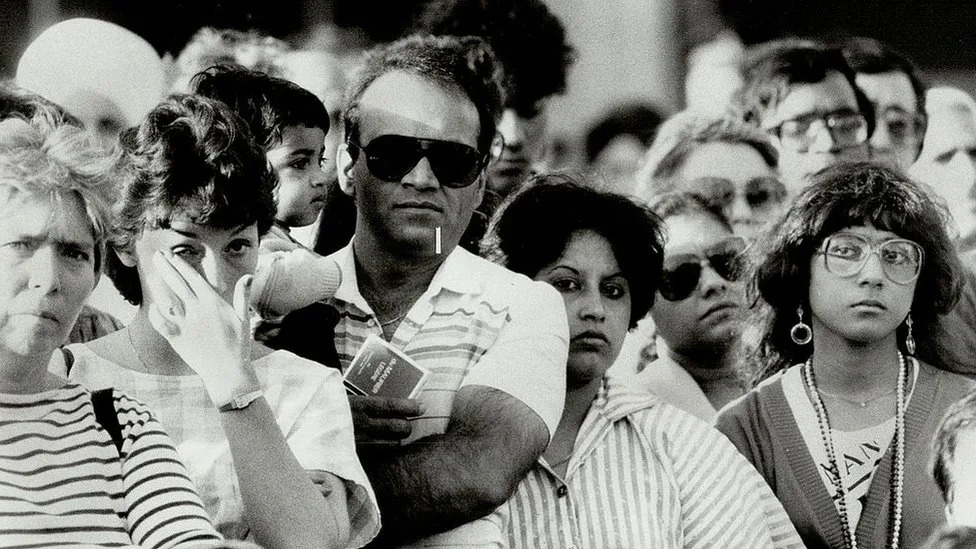
Mourners at the Nathan Phillips Square in Toronto a day after the bombing in 1985
The deadly bombing of an Air India flight in 1985 is back in the news after relations between India and Canada hit a new low.
Last week, Canadian Prime Minister Justin Trudeau said his country was investigating "credible allegations" that could link the Indian government to the murder of a Sikh separatist leader in British Columbia. India has denied the allegations, calling them "absurd".
Since then, several commentators in India have brought up the 1985 attack - also known as the "Kanishka bombing" because the Boeing 747 was named after the Emperor Kanishka - which also strained Delhi-Ottawa ties.
What happened in 1985?
On 23 June 1985, an Air India flight travelling from Canada to India via London, exploded off the Irish coast, killing all 329 people on board. The cause was a bomb in a suitcase that was transferred to the flight even though the ticket holder had not boarded. The victims included 268 Canadian citizens, mostly of Indian origin, and 24 Indians. Only 131 bodies were retrieved from the sea.
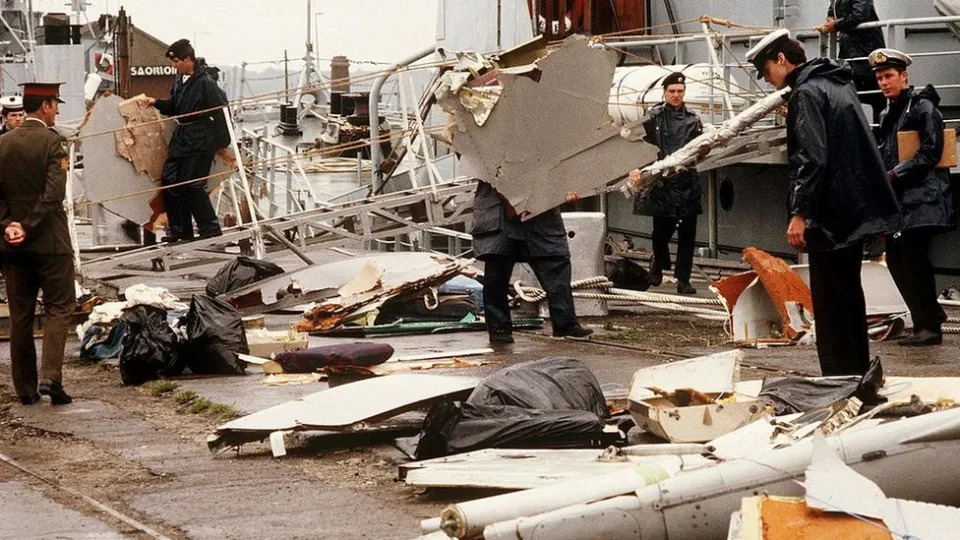
Irish naval authorities in Cork bring debris ashore on 28 June 1985
While the flight was still in the air, another explosion at Tokyo's Narita airport killed two Japanese baggage handlers. Investigators later said that this bomb was linked to the attack on Flight 182 and intended for another Air India flight to Bangkok but it exploded prematurely.
Who was behind the attack?
Canadian investigators have alleged that the bombings were planned by Sikh separatists who wanted to take revenge for the Indian army's deadly 1984 storming of the Golden Temple in Punjab state.
A few months after the attack, the Royal Canadian Mounted Police (RCMP) arrested Talwinder Singh Parmar - the leader of an extremist group called Babbar Khalsa that is now banned in Canada and India - and Inderjit Singh Reyat, an electrician, on various weapons, explosives and conspiracy charges.
But the case against Parmar - whom India had unsuccessfully tried to get extradited from Canada in the early 1980s - was flimsy and he was released. Investigators now believe that Parmar - who was killed by police in India in 1992 - was the mastermind behind the attack.
In 2000, police arrested Ripudaman Singh Malik, a wealthy Vancouver businessman, and Ajaib Singh Bagri, a mill worker from British Columbia, on a number of charges including mass murder and conspiracy.
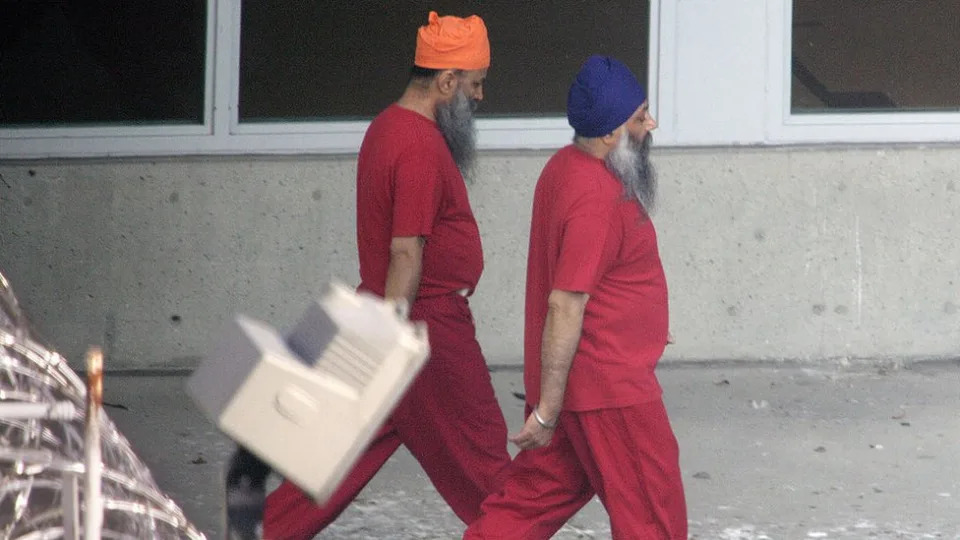
(From left) Ripudaman Singh Malik and Ajaib Singh Bagri at a jail in Vancouver in 2004.
But in 2005, after an expensive trial that lasted almost two years, both men were acquitted of all charges - the judge said there were factual errors and credibility issues with key witnesses who testified against the men. The BBC reported at the time that the verdict was greeted with shock, with victims' relatives sobbing in the courtroom.
Mother's shock at Air India verdict
Reyat was the only person to be convicted in connection with one of the world's worst aviation terror attacks. He was jailed in the UK for 10 years in 1991 for his involvement in the Japan bombing. In 2003, he pleaded guilty in a Canadian court to manslaughter in connection with the bombing of Flight 182, and was sentenced to another five years in prison. He was also later convicted of perjury at the trial of Malik and Bagri, and given an additional jail sentence.
Why was the investigation criticised?
Canadian authorities have been accused of not doing enough to prevent the attack and of bungling the investigation. After outrage from victims' families over the acquittal of Malik and Bagri, the Canadian government set up a public inquiry in 2006, headed by a former Supreme Court judge, to look into the bombing. It concluded in 2010 that a "cascading series of errors" had led to the "largest mass murder in Canadian history".
The inquiry heard that an unidentified witness had warned Canadian police of a plot to blow up a plane months before the attack.
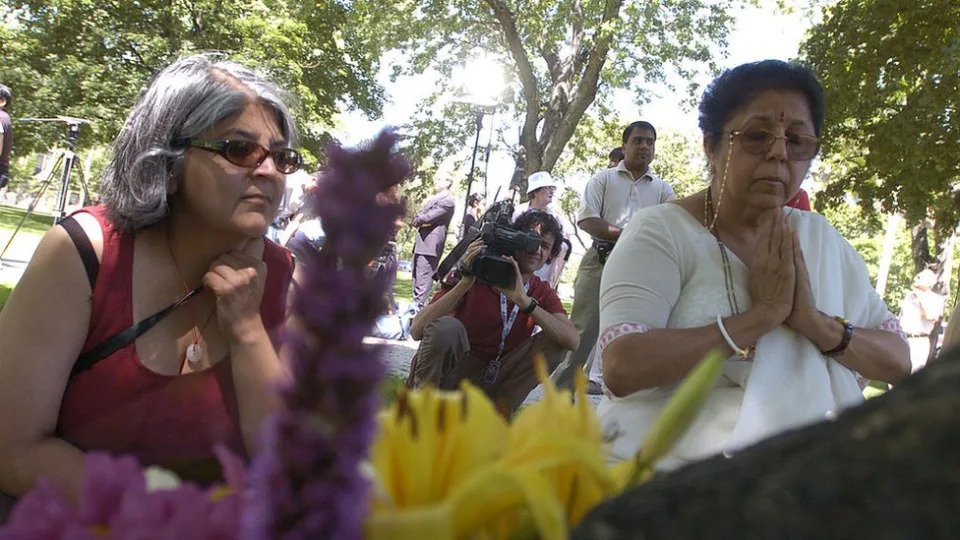
Relatives of the victims at a memorial in Toronto in 2005.
It also emerged that in the weeks before the attack, members of the Canadian secret services had followed Parmar and Reyat to some woods on Vancouver Island where they heard "a loud explosive sound", but did not regard this as important.
In the 1990s, two Sikh journalists who may have been key prosecution witnesses, were murdered in separate incidents in London and Canada - one of them was already in a wheelchair after an earlier shooting.
In 2000, a former Canadian secret services officer told a newspaper that he destroyed tapes with 150 hours of telephone calls made by Sikh suspects instead of handing them over to the RCMP as he feared it could reveal the identity of the informants.
Unravelling Canada's 1985 Air India investigation
In 2010, after the inquiry report was released, then Canadian Prime Minister Stephen Harper offered a public apology to the families of the victims - he said their "legitimate need for answers and indeed, for empathy, were treated with administrative disdain" for years.
In 2016, Reyat was released from a Canadian prison after serving two-thirds of a nine-year sentence - the next year, he was also allowed to leave a halfway house and live where he wanted to, a decision some experts criticised.
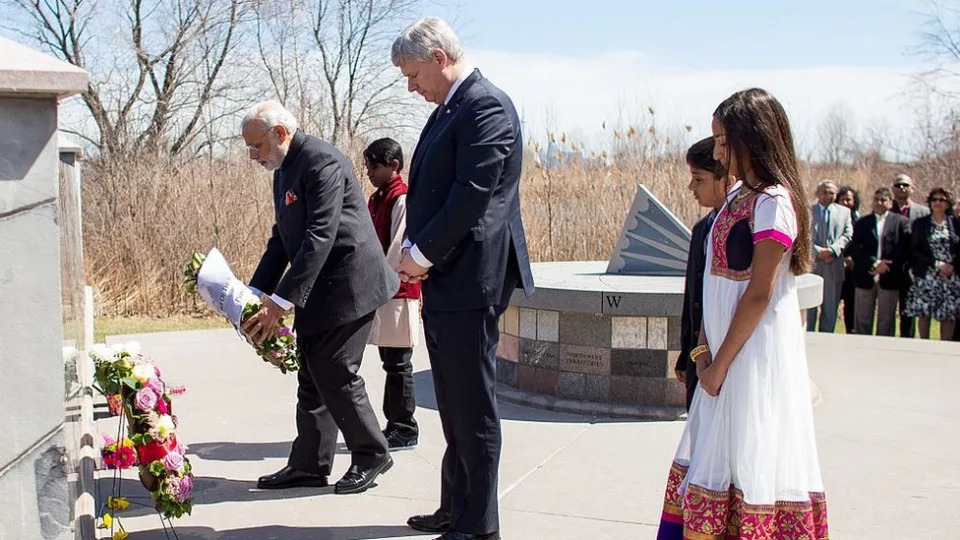
Indian Prime Minister Narendra Modi (left) and his then Canadian counterpart Stephen Harper leaving wreaths at a memorial in Toronto in 2015
Last year, Ripudaman Singh Malik was shot dead in his car in Surrey, British Columbia in what police described as a targeted killing - they arrested two men on charges of first-degree murder. Their motive isn't clear.
A study released by the Angus Reid Institute earlier this year around the 38th anniversary of the Air India bombing found that the tragedy is still "a relatively unknown piece of Canadian history" - they found that nine in 10 Canadians have little or no knowledge of the attack.
What about the reaction in India?
The Air India bombings have long evoked painful memories in India - while the majority of the victims were Canadian citizens, most of them were of Indian origin and had relatives in the country. The overwhelming sentiment in India is that justice has not been delivered to the victims.
In 2006, Canadian lawyer Richard Quance travelled to India to meet some of the relatives of the victims - he told the BBC that the families in India felt "excluded from the judicial process" and had questions about the process that led to the acquittals of Malik and Bagri.
Indian families left bereft by the bombing felt "neglected and left out", Amarjit Bhinder, whose husband was the co-pilot on the Air India flight, told the BBC at the time.
The recent row between the countries has also brought the tragedy back into discussion in India - a federal minister recently tweeted about it, calling the bombing "one of the most reprehensible acts of aviation terror against India" and criticising the "mindsets that tolerated & even condoned" the act. Several news stories and opinion pieces have also remarked on the missteps by Canadian authorities in the run-up to and after the bombings.
Over the years, families of those who died have spoken of their anguish.
"I still meet people today who were somehow connected with the Air India bombing - my kindergarten daughter's teacher was a schoolmate of a victim. It is surprising how widely the bombing affected Canadians," says Susheel Gupta, who was 12 when his mother died.
Rod Nickel and Rajendra Jadhav
Updated Tue, September 26, 2023
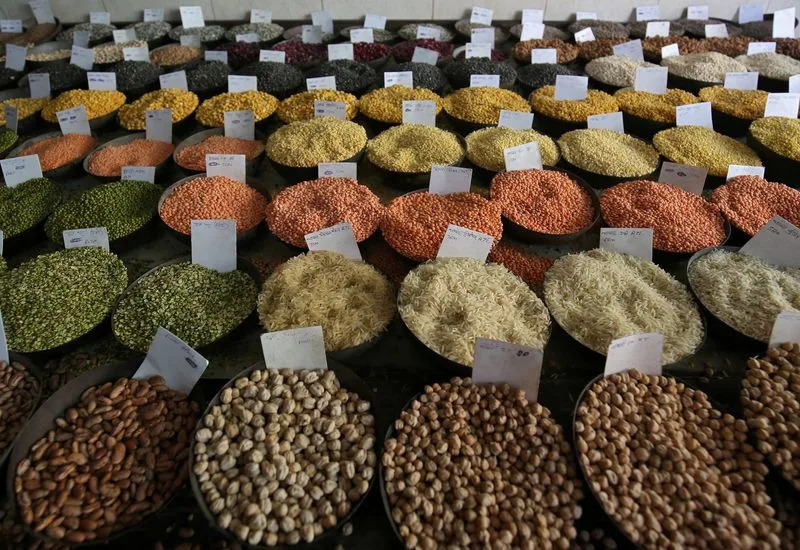
WINNIPEG, Manitoba/MUMBAI (Reuters) -Canadian lentil sales to India have slowed since Canadian Prime Minister Justin Trudeau said last week he suspected India of involvement in an assassination on Canadian soil, fearing reprisal from New Delhi that could limit trade, industry sources in both countries say.
Trudeau said that Canada was "actively pursuing credible allegations" linking Indian government agents to the murder of a Sikh separatist leader in British Columbia in June. India's foreign ministry called the allegations "absurd."
Canada is India's main import source of lentils, a protein-rich staple used to make daal curry.
Reduced Indian purchases would likely cut the prices Canadian farmers receive during harvest. But such a move could also inflate India's domestic food prices, which would be politically risky ahead of a national election next year.
After a drop in output, India banned wheat exports last year, followed by a ban on non-basmati white rice this year to preserve supplies of those staples.
"Industry officials are concerned that there could be trade restrictions by the governments owing to current tensions between the countries," said Nitin Gupta, senior vice president of Olam Agri India, a major importer.
There are no such plans by India and Delhi has not instructed importers to refrain from purchases, said a senior Indian government official, declining to be named due to the sensitivity of the situation.
The Indian government has suspended issuing visas to Canadians and each country has expelled some diplomats.
Canada is not currently taking any action that would directly affect trade with India, said an official with the Canadian Global Affairs department, declining to be named.
Indian buyers bought significant supplies of Canadian lentils earlier in the year for delivery after harvest, said Kevin Price, senior export merchant at Winnipeg-based crop trader Parrish & Heimbecker.
"Obviously we're concerned about making sure (the sales) get executed," Price said, adding that he's not aware of any cancellations. "Do they want to take on more now? No. They're taking a wait-and-see" attitude.
Due to India's poor crop, lentil prices are high, but since Trudeau's comments Indian offers for Canadian supplies have dropped 6% to around $770 per metric ton, Price said.
A second Canadian exporter said while Indian buyers have become hesitant, overall global demand for lentils remains strong.
Canada was the biggest supplier of lentils to India during India's 2022/23 financial year ended on March 31 with shipments of 485,492 metric tons worth $370 million, accounting for more than half of India's total lentil imports, according to data from India's trade ministry.
The trend had been continuing, with India's imports of Canadian lentils from April to July jumping 420% from a year ago to 190,784 tons, the trade ministry data showed.
India consumes around 2.4 million metric tons of lentils annually, but local production falls short at 1.6 million tons, said Bimal Kothari, chairman of India Pulses and Grains Association.
Indian buyers are now seeking lentils from Australia and slowing purchases from Canada, said a Mumbai-based dealer with a global trading firm, who was not authorized to speak publicly.
"Inflation within the pulses group is currently very high, making Canadian lentils a critical need for India. Any measures taken to restrict imports would likely contribute to inflation, and New Delhi would likely avoid such actions," the dealer said.
(Reporting by Rod Nickel in Winnipeg, Manitoba and Rajendra Jadhav in MUMBAI; editing by Timothy Gardner)
